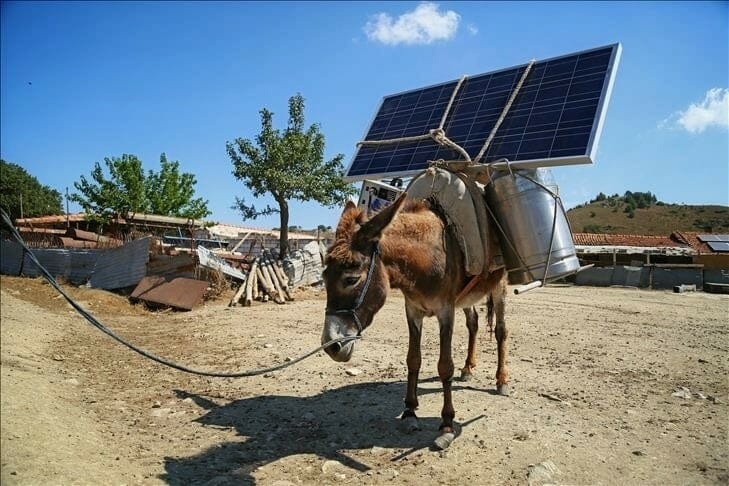Sun and AI: How Solar Energy Systems can be improved with Algorithms

I understand your doubts.
Which is the best solution to improve solar energy production?
Using artificial intelligence, how the title would suggest…
… or mounting solar panels on a donkey, as in the pic above?
Read the article to discover it!
Solar energy today
Nowadays, photovoltaic tech is definitely a hot topic.
Hot in all senses.
It is one of the main types of renewable energy technologies and has been developed to meet the growing demand for electricity while safeguarding the environment.
Following a global trend towards renewable energy sources, this sector has benefited from significant investments aimed at improving its yield and making it competitive.
At the same time, the costs of generating energy from photovoltaic panels have significantly dropped. According to research, we are talking about a 73% decrease between 2010 and 2017.
Even I can afford them, if I stop eating, drinking, smoking, and buying toy soldiers.
“The costs of generating energy from photovoltaic panels have significantly dropped. According to research, we are talking about a 73% decrease between 2010 and 2017.”
Each solution leads to other problems
Photovoltaic panels convert solar radiation into electricity thanks to semiconductor materials.
As you can imagine, their performance strongly depends on solar radiation, weather conditions, temperature, and the geographical location of the installation.
Excluding the position of the panel, which normally does not change (if we do not consider devices mounted on cute donkeys), all the other parameters listed above are clearly very variable over time.
This means that the energy output of photovoltaic panels is pretty unstable.
A real headache for energy sector players
One of the most challenging tasks for energy market operators is to manage this variability of production.
This is necessary in order to avoid the waste of electricity produced by renewable energy plants and to ensure sufficient energy to cover the customers’ needs.
Especially in the short term (a few hours), transmission system operators need to find the right balance for the entire grid, to avoid possible penalties applied in case of excessive or lower electricity generation.
Electricity traders, on the other hand, are more focused on long-term fluctuations in energy production (one-day intervals).
Accurate forecasting of the next day’s production is essential for successful financial market operations as most of the electricity is traded on the day-ahead market.

How can AI support solar energy production?
In recent years, skyrocketing data availability and computing power have enabled machine learning algorithms to offer better predictions about the fluctuations mentioned above.
Machine learning is a fascinating branch of AI. It specializes in creating computer algorithms that can automatically improve their performance through experience.
ML algorithms are able to recognize specific patterns in data sets, build mathematical models to represent them, and use these models to make predictions or decisions without being explicitly programmed.
A further step forward has been taken with the rise of deep learning, an evolution of machine learning that mimics the mechanisms of the human brain to process information by using deep artificial neural networks (ANNs).
All these innovations have been implemented in the field of solar energy in a variety of ways, including:
- AI-based forecasting
- Smart power grids and storage units
- Drone technology for solar panel inspection
- Market expansion
1. AI-based forecasting
Nowadays, machine learning models are widely used to improve forecasting activities and stabilize solar energy production. Among them, we can find SVM (support vector machines), gradient boosting decision trees, and many others.
Researchers are testing various models under different conditions and locations to identify the most efficient ones, as their performance is still widely debated.
In addition to ML models, forecasting can also count on more traditional statistical methods (especially time series models), which are mathematical formulas and techniques used historically for this kind of purpose.
Hybrid models are better
Actually, the experimental results showed that hybrid models combining ML methods and statistical methods achieved higher accuracy than pure ML models.
The superior performances of this mixed approach have been tested in various studies.
Among the many, Gigoni’s on the K-NN and quantile random forest machine learning algorithms, or Feng’s research about two-layer ML hybrid models to predict one hour ahead solar irradiance
That is why both machine learning and traditional time series techniques are commonly used for forecasting.
“The experimental results showed that hybrid models combining ML methods and statistical methods achieved higher accuracy than pure ML models.”
Forecasting models should be trained properly
As you may have guessed, there is no perfect model for forecasting. The accuracy of each model may vary based on the climatic conditions of the intended location.
This is because every machine learning-based model must be trained and accumulate experience to function properly.
This means that a model will work better if it has been trained with data collected on a specific site and during the time of year for which predictions need to be made.
Overall, adapting a specific model to a given environmental dataset can increase predictive performance over using a generic model trained with a representative dataset of many weather regimes.
That’s right, machine learning models have their comfort zone too!
2. AI to boost power grids and storage units
AI is not just the solar energy industry’s trusted clairvoyant. Algorithms are also reliable tools for improving power grids and for dealing with storage problems.
In fact, power grids can be equipped with numerous sensors to collect a large amount of data.
When analyzed by artificial intelligence, this data provides valuable information to network operators to provide greater control and flexibility.
For example, we can combine energy flow control systems with large industrial equipment, such as air conditioning units and furnaces, to automatically shut them down when power is low.
Making storage units smarter with AI
Energy storage technology plays a fundamental role in a context such as that of renewable energy, which is subject to seasonal dynamics.
To function properly, battery hardware must be associated with sophisticated software that controls power generation and consumption.
Basically, we are talking about intelligent storage units powered by AI and adjustable according to the supply flow.
Artificial intelligence and especially machine learning, by creating models based on previously collected data, can help manage these flows and store excess energy to avoid grid overloads.
Do you remember “Monty Python’s The Meaning of Life”, specifically the fat guy exploding?
That’s what we want to avoid.

3. Drone technology for solar panel inspection
Talking about AI and solar energy, we can also expect an increasing implementation of robotics technology. For example, to support remote inspection and maintenance activities.
Imagine flocks of autonomous drones engaged in non-stop analysis of solar panels, supported by artificial intelligence.
With Wagner’s Ride of the Valkyries as background music. OH YES!
Actually, drones already play a key role in solar panel inspections, when paired with machine vision tools.
That’s because they are able to collect data at least 50 times faster than manual methods while improving the safety of operations.
Drones can help us identify manufacturing defects, cracks, and other issues by collecting data through special thermal cameras.
This information is then analyzed by AI-based systems to assess the impact of the problem.
Detecting faults with ML algorithms
The analysis of images taken by our cute flying machines starts with image preprocessing. This phase is necessary to reduce the noise and enhance the defect visibility and pattern recognition.
Next, machine learning comes into play as classification and clustering algorithms are used to recognize faulty cells in the solar panel. Experts are still experimenting with different ML-based algorithms to find the most effective for this task.
For example, a team of Malaysian researchers developed a Support Vector Machine (SVM) classification method to detect microcrack defects in multi-crystalline solar cells, with an accuracy of more than 88%.
On top of that, its performance is likely to improve as the number of training champions increases.
4. AI and market expansion
The renewable energy sector can indirectly benefit from AI in terms of market expansion.
In fact, artificial intelligence allows us to collect and analyze data that provide useful information on energy consumption.
This helps suppliers to optimize their services and develop new business models. At the same time, retailers can use this information to target new consumers.
Anyway, we will delve into this topic in a future article on AI for marketing and business.
Stay tuned!
The future of solar energy is AI
In the near future, AI will automate all the essential operations in the renewable energy sector.
Companies will proceed to install an increasing number of smart sensors, which will offer new insights to the grid operators.
These tools, coupled with the improvement of ML-based systems for monitoring data, will allow them to analyze and process information faster.
With the necessary investments, the solar energy sector is gonna show its full potential and start to shine. But all of this won’t just happen… overnight!
